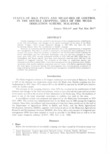Double cropping of rice has resulted in the increase of the cropping intensity, modification of the field microclimate, and changes in the species dominance of rice pests in the Muda Scheme. Tungro, which caused important damage in 1981-1983, has been the most devastating disease since the introduction of double cropping.
However, its occurrence has decreased thereafter due to the implementation of integrated pest management. Rice blast is second in importance, and generally more problematic in the second (wet) season. While the incidence of stemborers has declined after double cropping, the brown planthopper and the white-back planthopper took over and have emerged as major insect pests since 1978, causing widespread attacks in 1979, 1982 and 1983. Stink bugs, i.e. Scotinophara and Nezara species, have been more frequently observed since 1983 due to the adoption of staggered planting. The incidence of rice bugs, i.e. Leptocorisa species, also increased in the direct-seeded fields, where barnyard grasses served as alternate hosts. Rodent occurrence often reaches epidemic proportions once in 3 years, with Rattus argentiventer being the main agent. Continuous baiting with anticoagulants has received greater acceptance in large scale group farming projects. Integrated pest management should be further promoted to stabilize rice production.

